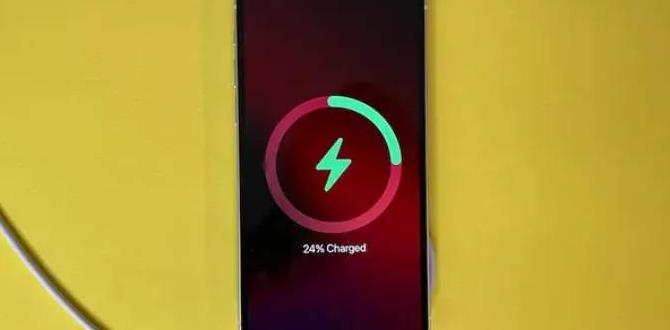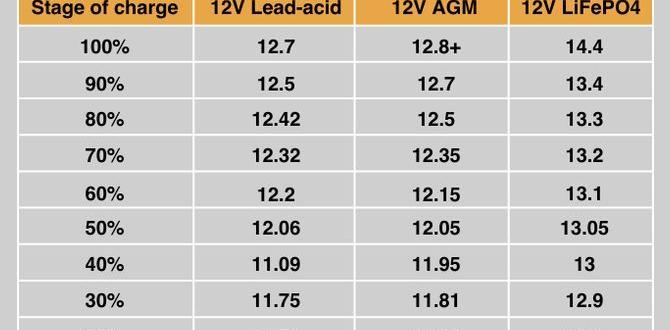Interstate doesn’t directly “pay” for old batteries in the sense of a cash bounty, but they offer significant value through their industry-leading recycling program. By participating, you contribute to environmental safety and often get a credit or discount on a new Interstate battery, making it a financially smart and responsible choice.
Dealing with a dead car battery can feel like a real headache, right? You’re trying to start your car, and nothing happens. Or maybe your phone battery just won’t hold a charge anymore, leaving you disconnected. It’s a common problem that can easily throw off your day. But don’t worry, figuring out what to do with the old battery is simpler than you think, and there’s a way to get value from it. We’ll walk through exactly how it works, making it easy for you to handle your battery needs safely and smartly.
Understanding the Value of Your Old Battery: It’s More Than Just Scrap
When your car battery or phone battery gives out, you’re often left wondering: “What do I do with this thing?” It’s heavy, it looks a bit intimidating, and frankly, it’s probably not something you want sitting around your garage. Many people don’t realize that these old batteries aren’t just trash; they hold valuable materials that can be reused. This is where companies like Interstate Batteries shine, offering a system that benefits you and the environment.
Instead of tossing an old battery, which can be harmful to the environment, participating in a recycling program means these materials get a new life. For car batteries especially, lead and plastic are recovered and processed for new products. This not only reduces waste but also conserves natural resources. Interstate has built a reputation on this commitment, ensuring that when you bring in an old battery, you’re part of a positive cycle.
The Interstate Batteries Recycling Program: How It Works
Interstate Batteries is well-known for its high-quality car batteries. What many consumers appreciate is their robust recycling program. This isn’t just a small initiative; it’s a core part of their business model that emphasizes sustainability and community return. When you buy an Interstate battery, you’re often participating in this program from the start.
Here’s a simple breakdown of how their battery recycling often works:
- Core Charge and Return: When you purchase a new car battery, especially from a dealer or authorized service center, you’ll likely pay a “core charge.” This is an extra fee added to the price. The idea is that you will return your old battery (the “core”) to get this charge refunded. It’s an incentive to ensure old batteries are properly handled.
- Value in Recycling: Interstate actively collects these old batteries. The lead inside is a valuable commodity, and the plastic casing can also be recycled. By collecting and processing these materials, Interstate reduces the need to mine for new lead and saves energy in manufacturing.
- Environmental Responsibility: Disposing of batteries improperly can release harmful chemicals like lead and sulfuric acid into the ground and water. Interstate’s program helps prevent this, making it an environmentally responsible choice for consumers. You can learn more about battery recycling at the U.S. Environmental Protection Agency website, which highlights the importance of proper disposal and recycling for lead-acid batteries.
- Partnerships for Convenience: Interstate partners with thousands of local service centers, repair shops, and retailers. This makes it easy for you to drop off your old battery when you get a new one installed or simply when you have an old one ready for recycling.
“How Much Does Interstate Battery Pay for Old Batteries?” Answering Your Core Question
This is the big question many people have: “How much does Interstate pay for old batteries?” The straightforward answer is that Interstate doesn’t typically offer direct cash payments to individuals for old batteries. Instead, the “pay” comes in the form of the core charge refund. This system is designed to encourage participation and streamline the recycling process.
Let’s break down how this usually works:
When you buy a new car battery, especially from an automotive parts store or a mechanic installing it for you, the price often includes a core charge. This charge varies but can typically range from $10 to $25 or more, depending on the battery type and retailer. This amount is added to the battery’s price upfront.
The Value You Receive:
- When you bring your old battery back to the place where you bought the new one, they will refund you that core charge. This is the primary way you “get paid” for your old battery.
- Some auto shops or battery specialists might offer a small store credit or a discount on accessories if you bring in an old battery without purchasing a new one at that exact moment, but the core charge refund is the most consistent and widespread method.
Why this system?
- Encourages Recycling: The core charge incentivizes everyone to return their old batteries, ensuring they are handled responsibly.
- Supports the Recycling Infrastructure: It helps fund the collection, transportation, and processing of batteries, which has associated costs.
- Cost Management: The recycled materials, particularly lead, offset some of the costs of manufacturing new batteries.
So, while you might not be cashing a check from Interstate for your old battery, you are definitely getting value back in the form of that core charge refund. It’s a smart system that benefits both the consumer and the environment.
The “Core Charge” Explained for Beginners
Let’s make the “core charge” super clear. Think of it like a deposit. When you buy a new battery, the store adds a little extra money, this is the core charge. They do this because they know you’ll be bringing back your old battery. Once you bring back your old battery, they give you that deposit money back. It’s their way of saying, “Thanks for bringing us your old battery so we can recycle it properly!”
Example:
- New Battery Price: $150
- Core Charge: $20
- Total Price at Purchase: $170
- When you return your old battery: You get $20 back.
- Your final cost for the new battery: $150.
This is a standard practice for car batteries and some other automotive parts. It’s a win-win: you get a new battery, and the old one gets recycled.
Beyond Car Batteries: Your Phone and Power Banks
While Interstate is famous for car batteries, the principles of battery value and responsible disposal extend to your smaller electronics too. Your phone battery and power banks also contain valuable materials. Though direct buy-back programs for small consumer electronics batteries aren’t as common as car battery core charges, responsible recycling is still key.
Phone Batteries: A Different Kind of Value
Phone batteries are typically lithium-ion. While they don’t have the same scrap value as lead in car batteries, they contain metals like cobalt and lithium that are important and can be recovered. Unfortunately, few retailers offer direct cash for old phone batteries.
What You Can Do:
- Manufacturer Trade-In Programs: Many phone manufacturers and carriers offer trade-in programs when you upgrade. While they might not give you cash for just the battery, the overall value of your old device (including the battery) can be credited towards a new purchase.
- Retailer Recycling Bins: Major electronics retailers (like Best Buy in the U.S., or similar stores in other regions) often have free drop-off bins for small electronics and batteries. These programs are typically run by specialized recycling partners who can safely process these items.
- Local E-Waste Events: Keep an eye out for local electronic waste (e-waste) recycling events in your community. These are great opportunities to responsibly dispose of old phones, batteries, and other electronics.
The key takeaway is that even for your phone, there’s a responsible way to handle the old battery. While you might not get cash back directly, you’re contributing to a circular economy and preventing potentially harmful materials from ending up in landfills.
Power Banks: Portable Power, Portable Responsibility
Power banks, like phone batteries, are usually lithium-ion. They are incredibly useful for keeping our devices charged on the go. When a power bank stops holding a charge effectively, the best course of action is responsible recycling.
Recycling Power Banks:
- Electronics Retailers: As mentioned with phone batteries, many electronics stores have recycling programs for small electronics, including power banks.
- Community E-Waste Programs: Similar to phones, power banks can be taken to designated e-waste drop-off locations or events.
- Check the Manufacturer: Some power bank manufacturers may have their own take-back or recycling programs. It’s worth checking their website or customer service if you’re unsure.
The “pay” here isn’t financial. It’s the peace of mind knowing you’re not contributing to electronic waste pollution and that valuable components are being managed by professionals. It’s about ensuring our portable power solutions have a responsible end-of-life.
The “Proven Value” of Interstate Batteries: Beyond the Core Charge
Interstate Batteries’ “Proven Value” extends far beyond just the core charge refund for old batteries. Their brand is synonymous with reliability, performance, and a deep commitment to their customers and the environment. This creates a multifaceted value that consumers can trust.
Durability and Reliability
Interstate Batteries are engineered for demanding conditions. They are known for:
- Longer Lifespan: Compared to many other brands, Interstate batteries often last longer, meaning you won’t be replacing them as frequently. This saves you money in the long run and reduces the hassle of unexpected battery failures.
- Consistent Performance: Whether it’s extreme heat or cold, Interstate batteries are designed to deliver consistent power when you need it most, ensuring your car starts reliably every time.
- Robust Construction: They are built with high-quality materials and feature advanced designs to withstand vibrations and impacts, which is crucial for vehicles used in varied terrains or heavy-duty applications.
Extensive Network and Support
One of the major “proven values” of choosing Interstate is their widespread availability and excellent customer support.
- National Network: Interstate has one of the largest service networks in North America. This means you can find a reputable dealer or service center nearly anywhere, making warranty claims or finding a replacement battery straightforward.
- Expert Advice: The dealers and technicians associated with Interstate are often highly knowledgeable. They can provide expert advice on choosing the right battery for your specific vehicle and driving habits, ensuring you get optimal performance and value.
- Warranty: Interstate batteries typically come with strong warranties, offering you peace of mind. If you experience a defect or premature failure, their warranty process is usually fair and efficient, demonstrating their commitment to product quality. You can often find details on their warranty offerings on the official Interstate Batteries website.
Environmental Stewardship
As we’ve discussed, Interstate’s commitment to recycling is a cornerstone of their value proposition.
- Industry Leader in Recycling: They are pioneers in battery recycling, diverting millions of batteries from landfills annually. This proactive approach to sustainability is a significant value for environmentally conscious consumers.
- Resource Conservation: By reclaiming and reusing materials like lead, Interstate helps reduce the environmental impact associated with mining and raw material extraction.
Total Cost of Ownership
When you factor in the initial cost, lifespan, reliability, and the value of the recycling program, the total cost of owning an Interstate battery is often lower than less expensive, lower-quality alternatives. You pay for quality and an assurance of performance, which translates to fewer unexpected expenses and less inconvenience over time. It’s not just about the upfront price; it’s about the lasting performance and the responsible lifecycle.
When Do You Need a New Battery? Signs to Watch For
Knowing when your battery is nearing the end of its life is crucial to avoid being stranded. Batteries don’t last forever, and while they can degrade over time, several signs indicate it’s time for a replacement. Interstate batteries, like all batteries, have a finite lifespan, typically lasting between 3 to 5 years in normal conditions.
Common Warning Signs of a Failing Battery:
- Slow Engine Crank: This is perhaps the most common sign. When you turn the key, the engine cranks over slower than usual, with a “ruff-ruff-uhh” sound instead of a quick, strong start. This indicates the battery is struggling to provide enough power.
- Dim Headlights and Electrical Issues: If your headlights seem dimmer than usual, or if other electrical components (like the radio, power windows, or interior lights) are acting erratically or weakly, your battery might be weak.
- The Battery Warning Light: Most modern cars have a battery-shaped warning light on the dashboard. If this light comes on, it could indicate a charging system problem or a battery that’s failing. Don’t ignore it!
- Swollen or Leaking Battery Case: A battery that looks swollen or has visible leaks around the terminals is a serious issue. This can be caused by overcharging or extreme heat and means the battery is damaged and needs immediate replacement.
- A Sulfur or Rotten Egg Smell: A sulfuric smell coming from under the hood, particularly around the battery, can indicate a leaking battery or a faulty charging system. This needs to be checked immediately, as it can be dangerous.
- Old Age: If your battery is more than 3-4 years old, it’s operating on borrowed time. Even without obvious symptoms, it’s wise to have it tested during routine maintenance.
Your local Interstate dealer or a trusted mechanic can test your battery’s health for free using specialized equipment. Devices like a digital battery tester can measure the battery’s cold-cranking amps (CCA) and overall voltage, giving you a clear picture of its remaining life.
DIY Battery Replacement vs. Professional Installation
For many car owners, replacing a car battery is a manageable DIY project. However, it’s important to weigh the pros and cons of doing it yourself versus having it professionally installed by an Interstate dealer or mechanic.
DIY Battery Replacement
Pros:
- Cost Savings: You save on labor costs.
- Convenience: You can do it on your own schedule.
- Learning Experience: It’s satisfying to learn a new skill and understand more about your car.
Cons:
- Safety Risks: Car batteries contain corrosive acid and can produce explosive hydrogen gas. Mishandling can lead to severe burns or explosions. Always wear protective gear.
- Incorrect Installation: Reversing terminal connections can damage your car’s electrical system (the computer, alternator, etc.).
- Difficulty: Some car batteries are located in challenging spots (under the seat, in the fender well) that require specialized tools or significant effort to access.
- Disposal Hassle: You’ll need to figure out how to properly transport and dispose of or return your old battery to get your core charge back.
Professional Installation
Pros:
- Safety: Professionals are trained to handle batteries safely, minimizing risks.
- Expertise: They ensure correct installation, preventing damage to your vehicle’s electronics.
- Convenience: They handle everything, including proper disposal/return of the old battery.
- Warranty: Often, the installation itself may be covered by a labor warranty.
- Battery Testing: They can quickly test your charging system to ensure the new battery will perform optimally.
Cons:
- Labor Costs: You will pay for the mechanic’s time and expertise.
Tools for DIY (If You Choose This Route):
- Wrench set (often 10mm, 13mm, or 1/2 inch for terminals and hold-down clamp)
- Battery terminal cleaner brush
- Gloves (acid-resistant)
- Safety glasses
- Wire brush for cleaning terminals
- Anti-corrosion spray or grease
Steps for Replacing a Car Battery (DIY – Use with Caution):
- Safety First: Wear gloves and safety glasses. Ensure the car is off and the parking brake is engaged.
- Locate the Battery: In most cars, it’s under the hood.
- Disconnect the Negative Terminal FIRST: Use a wrench to loosen the nut on the black negative (-) cable clamp. Twist and pull the clamp off the terminal. Tuck it away so it can’t accidentally touch the terminal.
- Disconnect the Positive Terminal: Loosen the nut on the red positive (+) cable





